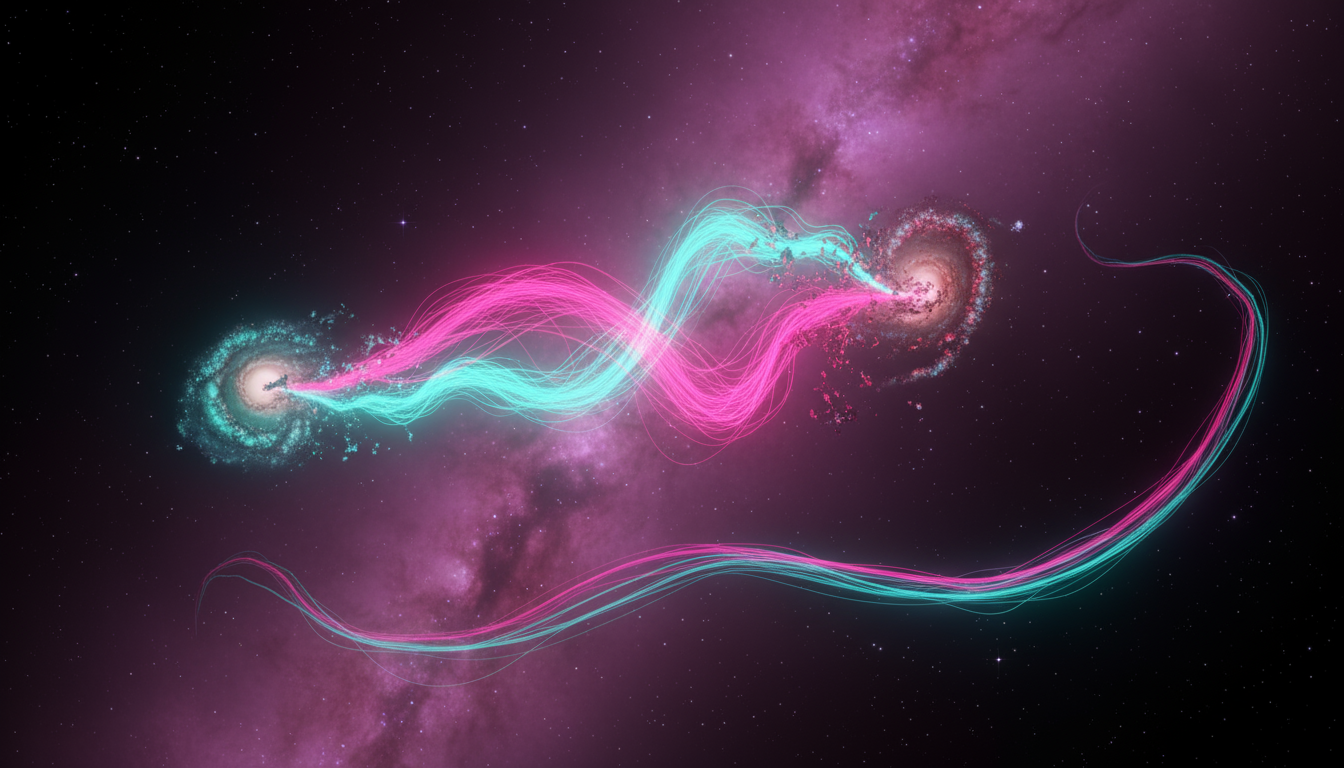Two small galaxies are being stretched across 480,000 light-years of space by the Virgo cluster. This is not science fiction. This is happening right now. And yes, the universe is absolutely brutal.

The Setup: Two Galaxies Walk Into a Cluster…
Somewhere in the cosmos, approximately 50 million light-years away, there’s a galactic tragedy unfolding in real-time. Two dwarf galaxies—NGC 4532 and DDO 137 (collectively known as WALLABY J123424+062511)—are in the process of being systematically destroyed by gravitational forces from the Virgo cluster, one of the largest structures in the universe.
The culprit? Not a collision. Not a merger. Just pure, relentless tidal forces from a galaxy cluster so massive it’s warping space itself. Imagine being in a swimming pool while someone drains it from both sides. Except the pool is made of gas and stars, and the “draining” force can be measured in millions of solar masses. (Staveley-Smith et al. 2025, MNRAS)
What the Hell Are We Actually Looking At?
The WALLABY pilot survey (Widefield ASKAP L-band Legacy All-sky Survey) uses radio telescopes to detect neutral atomic hydrogen (HI)—plain hydrogen atoms floating in space. When you map out all that hydrogen, you can see the skeleton of galaxies and, more importantly, the cosmic carnage happening between them.
The 48 Kiloparsec Bridge: A Gas Bridge from Hell
A massive bridge of hydrogen gas spanning 48 kiloparsecs connects the two galaxies—roughly 156,000 light-years of pure stretched material. To put that in perspective, our own Milky Way spans only about 100,000 light-years across. This bridge literally stretches longer than our entire galaxy.
But here’s the kicker: this bridge shouldn’t exist. Under normal circumstances, gravity would either pull the galaxies together into a merger or tear them apart cleanly. Instead, mutual gravity and cluster forces lock them in a grotesque cosmic dance, continuously stretching material between them like taffy.
The 0.5 Megaparsec Tail: The Universe’s Longest Cosmic Wound
Furthermore, a tail of gas extends 0.5 megaparsecs away—roughly 1.6 million light-years. The Arecibo Observatory first identified this tail before its collapse in 2020. This material gets ripped away by the Virgo cluster’s gravitational grip.
Essentially, this represents spaghettification on a cosmic scale.
How Is This Actually Happening?
Tidal Forces: Gravity’s Cruelest Weapon
The Virgo cluster’s gravity pulls unevenly on the two galaxies, stretching one side more than the other. Over billions of years, that difference tears the system apart—the same physics that would spaghettify anything near a black hole.
Ram Pressure Stripping: The Cosmic Wind
But there’s another killer at work. The Virgo cluster’s hot gas envelops the galaxies. As NGC 4532 and DDO 137 fall through at around 880 km/s, the pressure literally blows gas off their disks. This ram pressure, combined with tidal forces, explains the massive gas loss observed. (Staveley-Smith et al. 2025)
Mutual Tidal Interaction: A Toxic Relationship
Meanwhile, the galaxies’ own gravity keeps them locked together even as they tear apart. Their mutual pull raises gas and distorts structure—a slow, destructive orbital dance that prevents a full merger.
🧠 Quick Cosmic Facts
- Distance: ~50 million light-years
- Bridge length: 48 kpc (~156,000 ly)
- Tail length: 0.5 Mpc (~1.6 million ly)
- Cluster: Virgo
- Observed with: ASKAP (WALLABY Survey)
The Bigger Picture
Similarly, the Milky Way actively strips gas from the Magellanic Clouds—a smaller-scale version of this process. Galaxy clusters like Virgo simply amplify that brutality. They function as gravitational warzones where violent forces reshape, strip, or annihilate galaxies entirely.
The Science Behind the Image
The ASKAP telescope—the Australian Square-Kilometre-Array Pathfinder—mapped all of this through the WALLABY survey. ASKAP’s radio imaging revealed the bridge and tail in stunning detail. You can explore the publicly released data cubes via the CSIRO ASKAP Science Data Archive (CASDA), which are free to use for research and educational purposes under open-access terms.
🔭 Want to see the real data? You can view the WALLABY J123424+062511 data cube directly through CASDA. It includes ASKAP’s neutral hydrogen maps of the 48 kpc gas bridge and the 0.5 Mpc tail—exactly what the research describes. The images get released under CSIRO’s open science license and qualify for free educational or non-commercial use.
The Bottom Line
The Virgo cluster systematically destroys NGC 4532 and DDO 137 through relentless gravitational forces. It’s tragic—but breathtaking. The universe evolves not through serenity, but through collision, pressure, and transformation.
At BrightRise Pulse, we celebrate that chaos. Because ultimately, even in destruction, the cosmos creates something new.
What Do You Think?
Would you want to witness a galaxy being shredded in real time, or does that idea give you cosmic anxiety? Drop your thoughts below or tag @brpulse — we’d love hearing how our readers interpret the universe’s more chaotic side.
🔗 Sources & Citations
- Staveley-Smith L. et al. (2025). “WALLABY pilot survey: the extensive interaction of NGC 4532 and DDO 137 with the Virgo cluster.” MNRAS, 543(1). DOI: 10.1093/mnras/staf1443
- ASKAP – Australian Square-Kilometre-Array Pathfinder
- CASDA – CSIRO ASKAP Science Data Archive (Public Visual Data)
- NASA – Large Scale Structures (Galaxy Clusters & Cosmic Web)